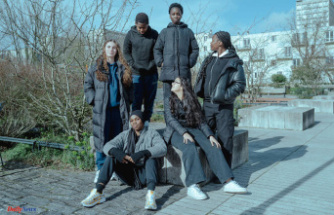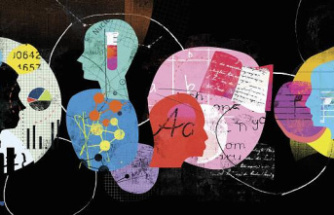In front of his computer, Thomas Loiseau puts the finishing touches to the features of his bodybuilding application. “The weight machines will have QR codes,” he explains. By flashing them, students will have access to information, for example on the correct use of each device. » This second-year master's student in "teaching, education and training professions" (MEEF), physical and sports education (EPS) course, at Paris-Nanterre University, spent several months develop its app, at the request of Josselin Duchemin, PE teacher in sciences and techniques of physical and sporting activities (Staps). The application allows you to directly calculate the weights to use and the number of repetitions to perform, based on your performance. Thomas designed it for the 1st grade class at the Alain high school, in Vésinet (Yvelines), which he is responsible for during his compulsory internship to validate his master's degree: “The goal is to save time during the session. That students be as independent as possible. »
In three years, Josselin Duchemin has modified the computer science course, now focused on the use of digital technology in teaching. This Friday morning in December, in small groups, students discover new applications, think about ways to use them during their future educational sessions, before testing them in the gym. Some of the students start a basketball match, while, on their smartphones, observers note: number of shots, lost balls, etc. At the end, the application displays the statistics, which provides avenues for progress. By promoting interactivity, the use of digital technology can have “a motivating side” for students, confides Samy Abdelmoumeni, M2 MEEF student.
The Staps sector is one of the most requested among the licenses offered on Parcousup, with more than 10,000 wishes expressed in 2023. In some establishments, the admission rate is barely 15%. Only between a third and half of those elected will complete the license in three years. This failure rate can be partly explained by a certain lack of awareness of the requirements of the sector, which includes sporting disciplines, but also scientific or social science disciplines. Hugues Rolan, director of the UFR Staps Sorbonne-Paris-Nord, also sees this as a consequence of the explosion in the number of students. In Bobigny, the Staps sector welcomes more than 1,300 in the first year, the lecture halls bring together up to 450 people. “The public is changing,” he notes, particularly since the Covid-19 epidemic. It becomes more difficult to grasp, “with fewer work habits”, which implies “finding tips to energize the lessons”.
Critically
“If I’m not in the interaction, I lose them,” says Cécile Dubeau, teacher at the UFR Staps at Paris Cité University. She uses the flipped classroom – all course materials are available in advance – but also digital tools, starting with videos and professional scenarios. So, on this Monday in November, L3 students begin by deciphering video clips. On the screen, two middle school students struggle to throw a ping-pong ball back and forth. The teacher encourages the students to exercise their critical outlook on the learning situation. “What does that tell you about the system put in place by the teacher? », she asks them. The principle of making level groups, leaving the worst ones together, shows its limits in thirty seconds. “Finding solutions to help them progress is your job,” she recalls. Ideas abound: move the table back, work on the backhand, improve your racket grip... or use a foam ball, whose rebound will be slower.
In the gymnasium, they then put their ideas into practice by proposing learning sequences to other L1 students. This afternoon, the course revolves around table tennis spin serves. Racket in hand, Daniel Morais Da Cunha shows how to cut a serve with a sharp gesture. Around him, around ten first-year students listen to the instructions. In pairs with Benjamin Douli, he will lead the class for twenty minutes. Cécile Dubeau listens, notes the positive and negative aspects, before debriefing with the two students. To design their learning situation, they are led to ask themselves concrete questions: “Do I group them together to give them instructions, or will I see them one by one? ", "Were my explanations clear enough? »
A way of combining theory and practice which prepares them to know how to deal with the situations they will encounter during their internship. As future teachers, they must know how to adapt both to the disparate levels of students and to the conditions of practice. Above all, this practice allows them to test what works or not, because often, “there is a big difference between the way we design the lesson and what we manage to implement”.
System D
The sector seems particularly conducive to the implementation of educational innovations, for various reasons. First, it quickly becomes professional, since at the end of the second year, students have a professional card which allows them to practice. The course, therefore, cannot “be just bookish”, believes Hugues Rolan. Multidisciplinary, the sector promotes collaboration between subjects and is shaped by the evolution of sport, the appearance of innovative equipment and technologies, which pushes it to adapt. But above all, it inherits its history, marked by a quest for academic recognition. Which, for Cécile Dubeau, pushes its actors to “intellectualize their educational practices” to “show their legitimacy”.
However, the establishment of these educational innovations at university relies essentially on the involvement of teachers and practices are still struggling to evolve globally. Nady El Hoyek, lecturer at the UFR Staps in Lyon-I, where he teaches anatomy, recalls that the necessary thinking work “mobilizes energy”, which some prefer to devote to scientific publication. Josselin Duchemin, who juggles three tablets in his course, also teaches his students to know where to look for funding to obtain equipment. System D is often used, while gyms are not always equipped with Internet.
For teacher Nady El Hoyek, also an educational advisor to the Ministry of Higher Education and winner of the Passion for Teaching and Pedagogy Prize in Higher Education, innovation requires “constantly questioning students about their expectations, their satisfaction, their impressions. , and to confront academic results”. At Lyon-I, even lecture courses become more interactive and are enhanced with quizzes, thanks to tools like Wooclap or Slido. A way of making students “actors of their learning”, says Hugues Rolan. “What is innovative today will no longer be innovative tomorrow”, insists the researcher, for whom innovating “does not mean changing its course every year”, but constantly reflecting on the educational purpose of what we are experimenting with. .












